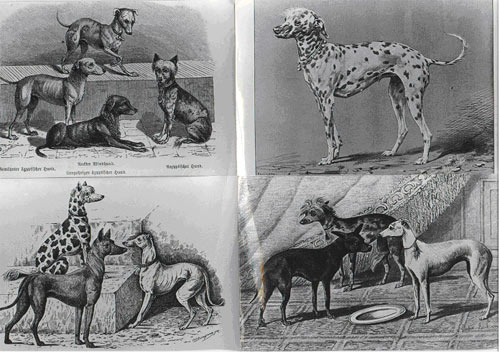HISTORY OF THE CHINESE CRESTED
- AN ANCIENT BREED -
The Chinese Crested is rumored to be descended from hairless dogs that were traded by sailors of many nationalities around the 17th and 18th Centuries. There is actually no historical evidence that the breed originated in China (or Africa), though hairless dogs have been recorded in many different parts of the world.
The only proven population of hairless dogs from that period were the 'pila dogs' of South America, a landrace of naturally hairless dogs that includes the modern-day Hairless Khala, Peruvian Hairless, and the Xoloitzcuintli, a 4,000 year-old breed kept by the Aztecs and Toltecs. Many Central and South American cultures revered (and ate) hairless dogs, believing they had healing properties. Many artifacts have been discovered depicting these dogs.
Because the main shipping routes of that era circled the entire globe, once the New World was discovered these pila dogs and pila-mixes were most likely transplanted by sailors to ports in many countries, leading to eventual confusion over their land of origin.
When examples of those hairless and semi-hairless dogs reached Europe in the 1800s, they gained a small following as curiosities, but were not seriously bred. The names given to these dogs varied widely, including 'African Hairless Terrier', 'Japanese Hairless', 'Mexican Crested' and many others. Eventually the name 'Chinese Crested' was settled on by breeders due to the belief at the time that there were no dogs native to the New World, and that all breeds found on that continent were simply imported from Asia. Despite the fact that modern archaeological and genetic findings have debunked that theory, the name remains.
The engraving below is of a Chinese Crested dog named Emperor who was shown in the UK in 1881. He looks virtually identical to dogs which are still seen to this day:
In the early 1900s, the respected Chihuahua breeder and judge Ida H. Garrett experimented with breeding Chinese Cresteds and wrote several articles about hairless dogs in general, but there was still no formal organization for the dogs and type varied widely. From 1920 to 1950, Ms. Garrett collaborated with a Ms. Debora Wood in collecting and promoting examples of Chinese Cresteds, but it wasn't until 1959 when Ms. Debora Wood created the Crest Haven Kennel and began to refine and develop the breed that an official breed standard was created.
It is believed that hairless Xolo-type dogs as well as various coated toy breeds were used as outcrosses in the early years, though Ms. Wood kept her stud books mostly private. However, it wasn't until Gypsy Rose Lee, a popular burlesque dancer and actress, also began promoting Chinese Cresteds that the general public began to take an interest in them. Crest Haven eventually incorporated Ms. Lee's dogs into it's own lines, and these two kennels were the foundation for every Chinese Crested alive today.
Ms. Wood also created the American Hairless Dog Club in 1959, which eventually became the American Chinese Crested Club (ACCC) in 1978. The breed was very rare and wasn't recognized by the AKC until 1991
The only proven population of hairless dogs from that period were the 'pila dogs' of South America, a landrace of naturally hairless dogs that includes the modern-day Hairless Khala, Peruvian Hairless, and the Xoloitzcuintli, a 4,000 year-old breed kept by the Aztecs and Toltecs. Many Central and South American cultures revered (and ate) hairless dogs, believing they had healing properties. Many artifacts have been discovered depicting these dogs.
Because the main shipping routes of that era circled the entire globe, once the New World was discovered these pila dogs and pila-mixes were most likely transplanted by sailors to ports in many countries, leading to eventual confusion over their land of origin.
When examples of those hairless and semi-hairless dogs reached Europe in the 1800s, they gained a small following as curiosities, but were not seriously bred. The names given to these dogs varied widely, including 'African Hairless Terrier', 'Japanese Hairless', 'Mexican Crested' and many others. Eventually the name 'Chinese Crested' was settled on by breeders due to the belief at the time that there were no dogs native to the New World, and that all breeds found on that continent were simply imported from Asia. Despite the fact that modern archaeological and genetic findings have debunked that theory, the name remains.
The engraving below is of a Chinese Crested dog named Emperor who was shown in the UK in 1881. He looks virtually identical to dogs which are still seen to this day:
In the early 1900s, the respected Chihuahua breeder and judge Ida H. Garrett experimented with breeding Chinese Cresteds and wrote several articles about hairless dogs in general, but there was still no formal organization for the dogs and type varied widely. From 1920 to 1950, Ms. Garrett collaborated with a Ms. Debora Wood in collecting and promoting examples of Chinese Cresteds, but it wasn't until 1959 when Ms. Debora Wood created the Crest Haven Kennel and began to refine and develop the breed that an official breed standard was created.
It is believed that hairless Xolo-type dogs as well as various coated toy breeds were used as outcrosses in the early years, though Ms. Wood kept her stud books mostly private. However, it wasn't until Gypsy Rose Lee, a popular burlesque dancer and actress, also began promoting Chinese Cresteds that the general public began to take an interest in them. Crest Haven eventually incorporated Ms. Lee's dogs into it's own lines, and these two kennels were the foundation for every Chinese Crested alive today.
Ms. Wood also created the American Hairless Dog Club in 1959, which eventually became the American Chinese Crested Club (ACCC) in 1978. The breed was very rare and wasn't recognized by the AKC until 1991


